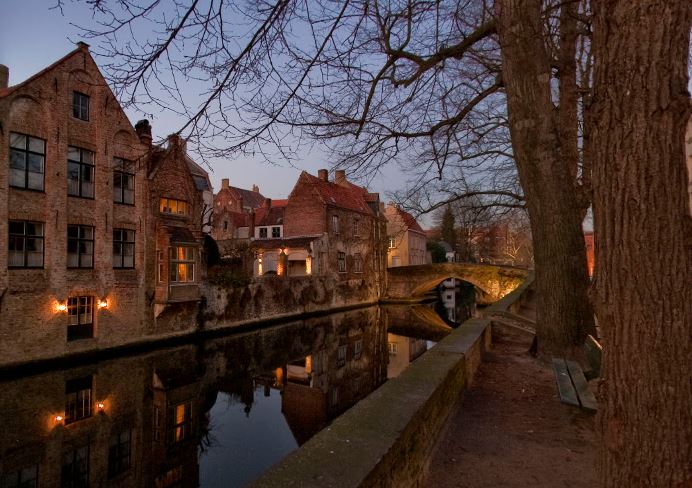
Johannes set the time and place for our meeting.
Fourth bench from the oldest stone crossing, when the 101 cast their bills to the west.
Typical Johannes.
My guidebook said the oldest stone crossing was the Meeburg. As for the 101 I hadn’t a clue … Then a flotilla of white darts scudded along the canal, their wake pointing to an egg yolk sky. I smiled – the 101 swans of Bruges, returning to their nests at sunset.
I walked Meestraat, remembering Mother’s words when I told her Johannes was an author and an oil painter.
‘Writers are liars and thieves. Artists are cowards.’
Not for the first time I wondered at her life before marrying my accountant father.
The bench was black with rain, golden with fallen leaves. Taped to the seat was a large cardboard sign.
New York calls me home. Enjoy the canals. J
I hate it when Mother’s right.
***
Written for What Pegman Saw, the prompt that uses Google Street View as its starting point. This week we are in Bruges, Belgium.
Notes.
*Being an art history graduate, the first thing that came to mind when I saw Pegman was in Bruges was the Flemish artist, Jan van Eyck (1390-1441) – also known as Johannes. Van Eyck is famous for many wonderful oil paintings, not least The Arnolfini Portrait. He has signed the portrait just above a representation of a mirror. It reads “Johannes de Eyck fuit hic 1434” – “Johannes van Eyck was here 1434”.
Visit here to learn the full story of the 101 swans of Bruges.
As far as I can make out, the Meebrug is the oldest stone bridge in Bruges. Other crossing places may be older, but the Meebrug is the oldest structure.

I smile at the image the name Bruges brought to your mind. Mine was wool, and the exchequer and the Edwards I, II & III.
Yours makes a good read. I abandoned mine and went for something… older
LikeLike
Yes, you can’t keep the art historian in me down! Now, wool’s an interesting one, especially in your part of the country, yes? I remember visiting some lovely Suffolk towns like Lavenham (not Norfolk, but close ish) and being told they were built on the wool trade.
LikeLike
My family were involved with the weaving. Not necessarily wool. Linen was also the thing around Aylsham and the Waveney… the Kemps originate around East Harling which was a centre of the old trade. But please don’t start me off this subject. I immersed myself fully a few years ago… I’ve a thing for textiles. Not that that shows in my writing 🙂
LikeLike
Weaving in your blood and it comes through so beautifully in your fiction :). I love an old textile – we went to the Mary Rose museum a few weeks ago. Cases of old shoes, hose, jerkins, as well as personal items like dice and books, instruments. Ah, magical
LikeLike
We have the Bridwell Museum, with all the old textiles. And a study centre with yet more. Dream time.
LikeLike
That is a terrific story. You give us riddles that intrigue and which simultaneously describe the character of Johannes and demonstrate his charm and fascination. And the descriptive writing is top-notch, too. You’re the sort of storyteller who makes the tale of Scheherazade seem believable!
LikeLike
Aw, thank so much, Penny. What a delightful comment -you’ve had me smiling from ear to ear. Thanks so much
LikeLike
Great story Lynn, and the perfect setting for a bit of intrigue and romance. Perhaps she will be better off without Johannes, it seems he would make life complicated!
LikeLike
Ah yes, falling for those artistic types is always a risk — but it can be worth it, at least in brief doses. Great sense of place and (emotional) time. Love the image of the wake of the birds pointing to the egg yolk sky, especially.
LikeLike
Ah, thank you, Joy. Really glad you liked that description. I do love descriptions, as you might have noticed 😉 Thanks again
LikeLiked by 1 person
One of my favourite pieces of yours, Lynn. Cracking.
LikeLike
Thanks so much, Matthew. That’s really kind of you to say so. Thanks for reading
LikeLiked by 1 person
Great voice and marvelous storytelling. The fathoms of story lurking between the line “‘Writers are liars and thieves. Artists are cowards.’”
and
“Not for the first time I wondered at her life before marrying my accountant father.”
was sublime 🙂
Lovely to see you!
LikeLike
Thank you so much, Karen. Yes, I think mother has her own story to tell about creative men! Thank you so much for the kind comment and for reading
LikeLike
I know there are all kinds of theories about that swan legend, medieval nobles and the Holy Grail, all very suggestive but all leading to dead ends. But the Arnolfini wedding portrait is one of those ‘mirror’ images that I love for their ambiguities. And also the enigmas in your stories…
LikeLike
There’s a lot to see in that portrait, which is why I chose it for my degree dissertation. It’s a very ‘gendered’ piece – all the references to his trade, to childbirth, that little dog … I could stare at it for hours. I’ve seen it a couple of times in the flesh, it’s only small really, yet Johannes packed a lot of meaning in. Thanks for reading Chris
LikeLiked by 1 person
I’m also always surprised at how much detail is packed into so relatively small a canvas. Like your very own miniatures! Wonderful.
LikeLike
Those Renaissance painters – especially the Northern Renaissance painters like van Eyck – did love detail. And realism. Some of that was down to the development of optics, but I’m sure I’ve no need to tell you that. I love van Eyck. One of my favourite artists
LikeLiked by 1 person